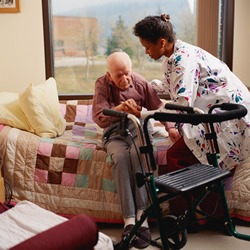Assaults on Nursing Assistants
Posted on by Nursing assistants are a critical part of the dedicated staff who work day and night in nursing homes to keep residents safe, secure, cared-for, and comfortable. Yet the very workers ensuring the safety of our seniors are themselves at risk for workplace violence and assaults.
Nursing assistants are a critical part of the dedicated staff who work day and night in nursing homes to keep residents safe, secure, cared-for, and comfortable. Yet the very workers ensuring the safety of our seniors are themselves at risk for workplace violence and assaults.
Recent NIOSH research based on the first large, nationally representative sample of nursing assistants reported that that nursing assistants in nursing homes have a high rate of work-related physical injuries from assault.1 Overall, 35% of nursing assistants reported physical injuries resulting from aggression by residents, and 12% reported experiencing a human bite during the year before the interview. Nursing assistants employed at nursing homes with special units for Alzheimer patients had a significantly elevated risk for assault injuries and human bites (37% reported injuries from assaults and 13% reported human bites).
Additional finding include:
- nursing assistants reporting mandatory overtime and not having enough time for assisting residents with activities of daily living reported more assault injuries and human bites
- Non-Hispanic Black nursing assistants were significantly less likely to report physical injuries from assaults and human bites
- older nursing assistants (aged 55 years or older) were least likely to report an injury from a resident’s assault
- those with job tenure of less than 12 months were significantly more likely to report physical assaults.
So how can we keep nursing assistants safe? Improving staffing levels may reduce the risk of assault by reducing workload demands and allowing staff more time to spend with each resident and avoiding the need to rush care. Additionally, nursing homes with specialized wings or wards for Alzheimer disease could benefit from more focused workplace violence prevention efforts.
Keeping nursing assistants safe is an important factor for retaining trained, motivated, and capable nursing assistants in long-term care. As the U.S. population ages, the need for nursing assistants will increase. It has been shown that nursing personnel who were subjected to work-related violence on at least a monthly basis reported higher intent both to leave the nursing profession and to change institutions. Research such as this is another step to understanding and improving the work environment for nursing assistants. We welcome input from readers on strategies that have worked to reduce violence against nursing assistants.
Dr. Tak is an epidemiologist in the NIOSH Division of Surveillance, Hazard Evaluations, and Field Studies
References
Posted on by

